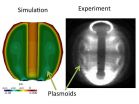(Press-News.org) A team of scientists at Virginia Commonwealth University has synthesized a powerful new magnetic material that could reduce the dependence of the United States and other nations on rare earth elements produced by China.
"The discovery opens the pathway to systematically improving the new material to outperform the current permanent magnets," said Shiv Khanna, Ph.D., a commonwealth professor in the Department of Physics in the College of Humanities and Sciences.
The new material consists of nanoparticles containing iron, cobalt and carbon atoms with a magnetic domain size of roughly 5 nanometers. It can store information up to 790 kelvins with thermal and time-stable, long-range magnetic order, which could have a potential impact for data storage application.
When collected in powders, the material exhibits magnetic properties that rival those of permanent magnets that generally contain rare earth elements. The need to generate powerful magnets without rare earth elements is a strategic national problem as nearly 70 to 80 percent of the current rare earth materials are produced in China.
The team's findings will appear in the article "Experimental evidence for the formation of CoFe2C phase with colossal magnetocrystalline-anisotropy," in a forthcoming issue of Applied Physics Letters.
Permanent magnets, specifically those containing rare earth metals, are an important component used by the electronics, communications and automobile industries, as well as in radars and other applications.
Additionally, the emergence of green technology markets - such as hybrid and electric vehicles, direct drive wind turbine power systems and energy storage systems - have created an increased demand for permanent magnets.
However, China is the main supplier of world rare earth demands and has tried to impose restrictions on their export, creating an international problem.
The current paper is a joint experimental theoretical effort in which the new material was synthesized, characterized and showed improved characteristics following the theoretical prediction.
"This is good science along with addressing a problem with national importance," said Ahmed El-Gendy, a former postdoctoral associate in the Department of Chemistry in the College of Humanities and Sciences and a co-author of the paper.
Everett Carpenter, Ph.D., a professor in the Department of Chemistry and director of the VCU's Nanoscience and Nanotechnology Program, said the new material is "already showing promise, even for applications beyond permanent magnets."
INFORMATION:
The research was supported by ARPA-e REACT project 1574-1674 and the U. S. Department of Energy (DOE) through grant DE-SC0006420.
COLLEGE PARK, Md. -- The introduction of Craigslist led to an increase in HIV-infection cases of 13.5 percent in Florida over a four-year period, according to a new study conducted at the University of Maryland's Robert H. Smith School of Business. The estimated medical costs for those patients will amount to $710 million over the course of their lives.
Online hookup sites have made it easier for people to have casual sex -- and also easier to transmit sexually transmitted diseases. The new study measured the magnitude of the effect of one platform on HIV infection rates ...
Selling one's body to provide another person with sexual pleasure and selling organs to restore another person's health are generally prohibited in North America on moral grounds, but two new University of Toronto Mississauga studies illustrate how additional information about the societal benefits of such transactions can have an impact on public approval.
The research, conducted by Professor Nicola Lacetera of the University of Toronto (Institute for Management and Innovation, U of T Mississauga, with a cross-appointment to the Rotman School of Management) and his ...
Going into space might wreak havoc on our bodies, but a new set of microgravity experiments may help shed light on new approaches for treating cartilage diseases on Earth. In a new research report published in the June 2015 issue of The FASEB Journal, a team of European scientists suggests that our cartilage--tissue that serves as a cushion between bones--might be able to survive microgravity relatively unscathed. Specifically, when in a microgravity environment, chondrocytes (a main component of cartilage) were more stable and showed only moderate alterations in shape ...
There's an urgent demand for new antimicrobial compounds that are effective against constantly emerging drug-resistant bacteria. Two robotic chemical-synthesizing machines, named Symphony X and Overture, have joined the search. Their specialty is creating custom nanoscale structures that mimic nature's proven designs. They're also fast, able to assemble dozens of compounds at a time.
The machines are located in a laboratory on the fifth floor of the Molecular Foundry, a DOE Office of Science User Facility at Berkeley Lab. They make peptoids, which are synthetic versions ...
GAINESVILLE, Fla. -- If a picture is worth a thousand words, UF Health Type 1 diabetes researchers and their colleagues have tapped into an encyclopedia, revealing new insights into how young people cope with the disease.
The sophisticated scientific instrument? A camera.
More than 13,000 children and teens are diagnosed with Type 1 diabetes each year. To find out more about their experiences as they live with this chronic disorder, a group of diabetes researchers from three universities, including the University of Florida, gave 40 adolescents disposable cameras and ...
People with achromatopsia, an inherited eye disorder, see the world literally in black and white. Worse yet, their extreme sensitivity to light makes them nearly blind in bright sunlight. Now, researchers at University of California, San Diego School of Medicine and Shiley Eye Institute at UC San Diego Health System have identified a previously unknown gene mutation that underlies this disorder.
The study published online June 1 in the journal Nature Genetics.
"There are whole families with this sort of vision problem all over the world," said Jonathan Lin, MD, ...
Researchers at the U.S. Department of Energy's Princeton Plasma Physics Laboratory (PPPL) have for the first time simulated the formation of structures called "plasmoids" during Coaxial Helicity Injection (CHI), a process that could simplify the design of fusion facilities known as tokamaks. The findings, reported in the journal Physical Review Letters, involve the formation of plasmoids in the hot, charged plasma gas that fuels fusion reactions. These round structures carry current that could eliminate the need for solenoids - large magnetic coils that wind down the center ...
There is a wealth of published information describing interactions between drugs used to treat cardiovascular disease and the genetic variations that can affect how patients respond to them. But few heart specialists make routine use of this potentially life-saving data.
To help physicians make better-informed clinical decisions, researchers from the University of Chicago and Stanford University combed through scientific literature on the pharmacogenomics of 71 leading cardiovascular drugs and compiled summaries, published in the June issue of the Mayo Clinic Proceedings.
"Tens ...
Academic programs that provide alternatives to traditional remedial education help students succeed at community colleges, but different programs result in a range of outcomes for various sub-populations of students. Drew Allen, a New York University doctoral student and director of the Office of Research, Evaluation, and Program Support at the City University of New York (CUNY), devoted his doctoral research to the evaluation of three current programmatic approaches at CUNY community colleges.
Entering community college students are often required to take remedial, ...
Some female members of a critically endangered species of sawfish are reproducing in the wild without sex. The discovery, reported in the Cell Press journal Current Biology on June 1, marks the first time living offspring from "virgin births" have been found in a normally sexually reproducing vertebrate in the wild, the researchers say.
Earlier evidence that vertebrates might sometimes reproduce via a process called parthenogenesis had primarily come from isolated examples of captive animals--including birds, reptiles, and sharks. In those instances, the animals in question ...

